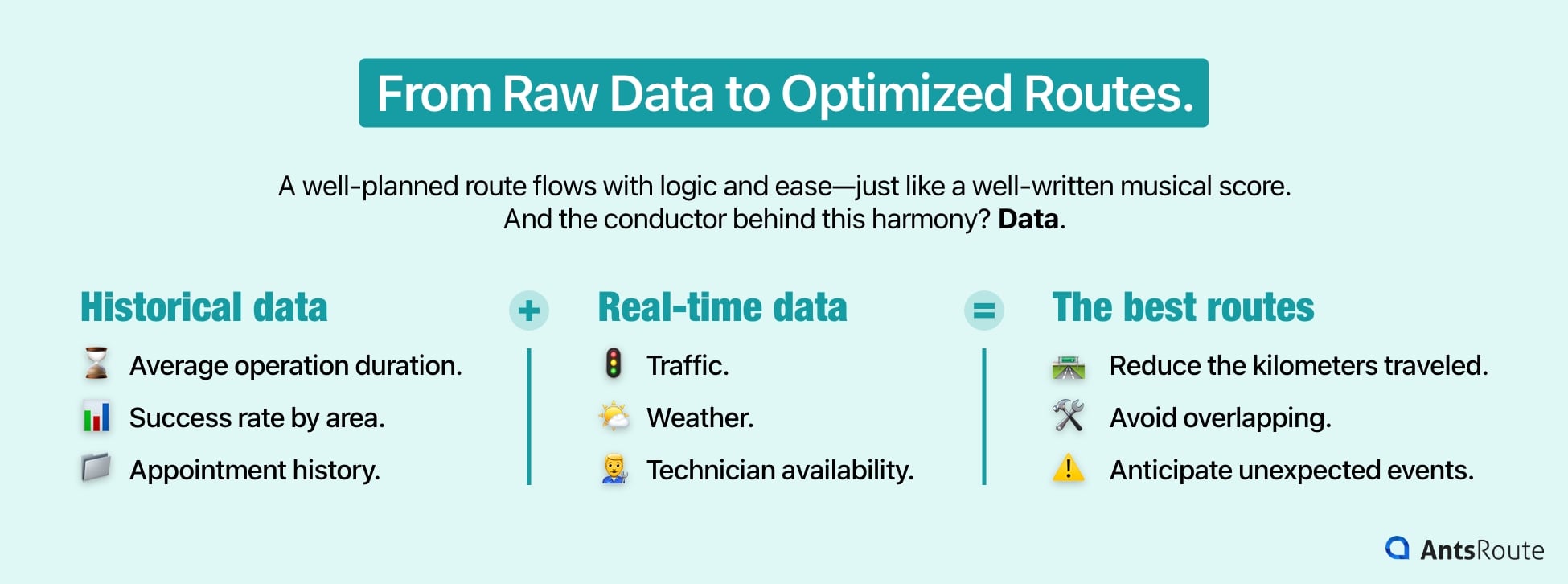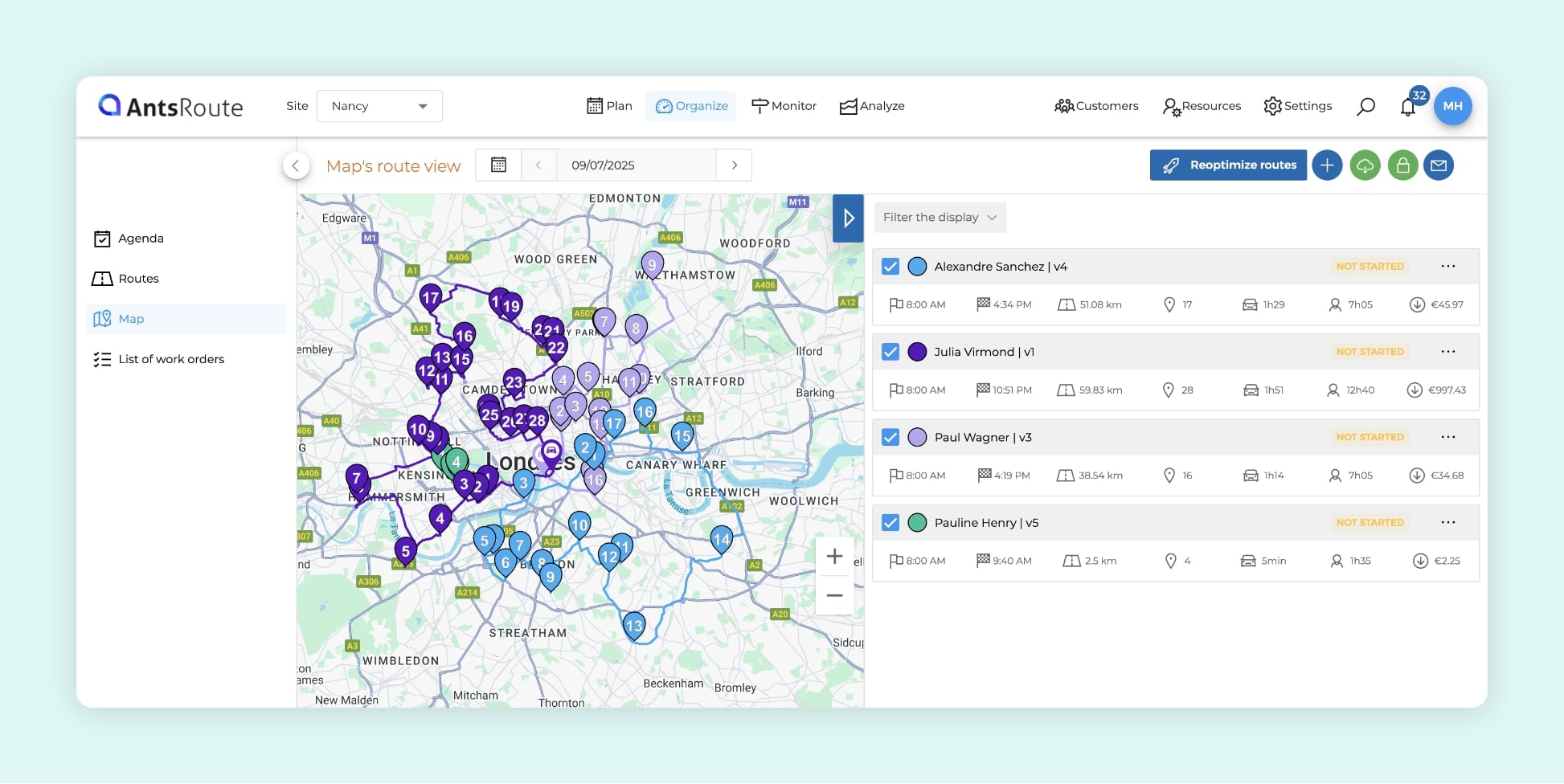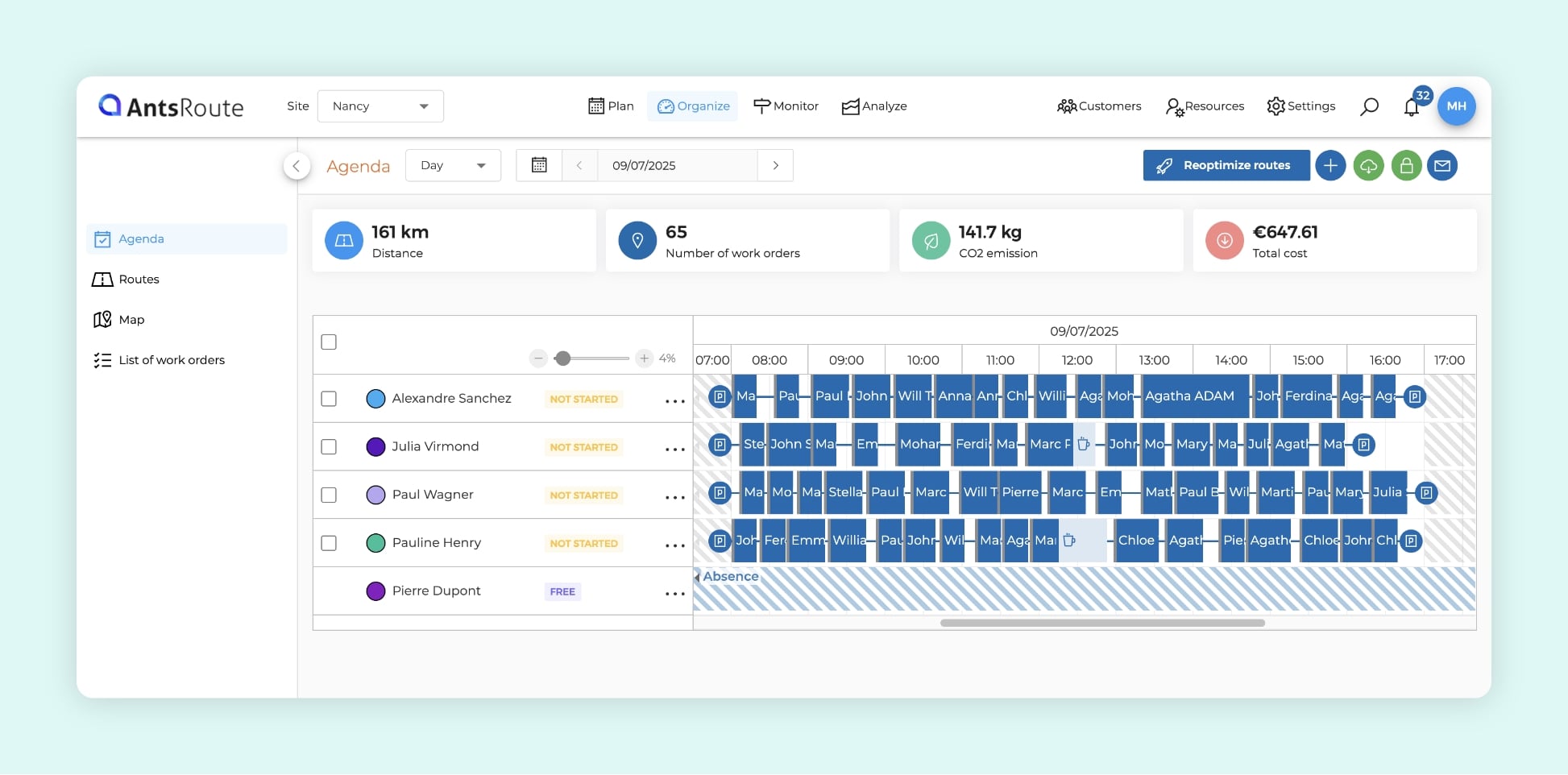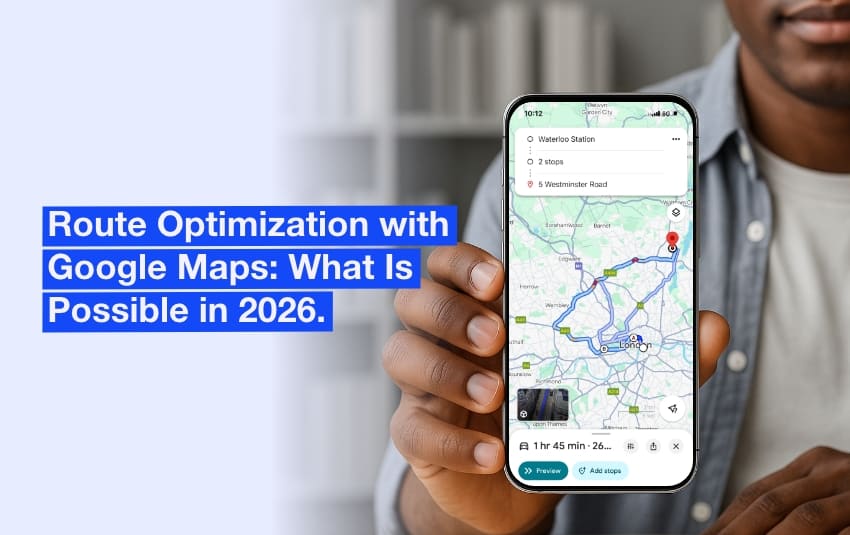Optimizing Field Operations: How Data Improves Your Routes, Scheduling, and Performance

Blog > Field Service > Optimizing Field Operations: How Data Improves Your Routes, Scheduling, and Performance
Optimizing Field Operations: How Data Improves Your Routes, Scheduling, and Performance
Published on 31 July 2025 • Reading time: 8 min read
Imagine a team of technicians that’s never late, always at the right place at the right time, and ends the day stress-free, proud of a job well done. Sounds like a dream, right? What once seemed utopian is now within reach—thanks to a quiet yet incredibly powerful ally: data.
In field-based professions, every minute counts. A missed appointment, an unnecessary detour, or a poor assignment—and the entire day can go off track. Yet many companies still rely on makeshift Excel schedules or gut-feeling decisions.
What if the key to improving efficiency, responsiveness, and customer satisfaction was already right in front of you? Travel times, work history, technician feedback… when used wisely, this data can completely transform route planning, schedule management, and team organization. No more improvisation—welcome to a proactive, agile, and data-driven approach.
In this article, discover how data can become a true strategic asset—helping you do more with less, without adding to your teams’ workload. Ready to follow along?
Table of contents:
- What if Your Field Decisions Were Finally Based on Something Concrete?
- Smarter Route Planning Through Data Analysis
- Optimized Technician Scheduling Through Data
- Dashboards to Monitor Performance in Real Time
- Lower Costs, More Satisfied Customers
What if Your Field Decisions Were Finally Based on Something Concrete?
Making data-driven decisions doesn’t mean handing your fate over to mysterious algorithms. It simply means relying on solid facts instead of intuition or habits. And in field operations, that difference can turn a chaotic day into a perfectly orchestrated one.
Data that Speaks (and Acts)
There’s a wealth of precise, actionable data available in the field:
- Number of completed tasks
- Distances traveled
- Work history (duration, type, outcome)
- High-density geographic zones
- Cost per operation
- Field feedback (customer reviews, technician notes…)
Once this information is collected and centralized, it becomes a true compass for decision-makers. Tools like AntsRoute automatically cross-reference this data to generate relevant recommendations.
Static schedules are a thing of the past—make way for real-time adjustments, greater responsiveness, and better anticipation of needs.

Field data to be collected and centralized.
The Right Tools to Make the Right Decisions
To move from observation to action, you need the right equipment. Here are the essential tools:
- Route optimization software capable of integrating real-time field constraints (traffic, availability, priorities, etc.).
- CRM (Customer Relationship Management) systems to centralize all information related to customers and service operations.
- Connected sensors (IoT) embedded in vehicles or equipment, which automatically transmit operational, geolocation, or maintenance data.
In short, everything you need to turn a flow of raw information into concrete, strategic, and profitable decisions. Result: a 360° view of your operations.
➡️ Check out our comparison of free tools to optimize your field operations.
Excel vs. Smart Software: A (Nearly) Lost Battle from the Start
Let’s compare two field teams:
- Team A relies on a manually updated Excel spreadsheet, internal messaging, and a lot of makeshift solutions.
- Team B uses a smart solution. Routes are recalculated based on traffic, drivers receive their assignments in real time, and the manager monitors all operations via a dynamic dashboard.
The verdict is clear:
☝️ Team B is punctual, drives fewer kilometers (and reduces CO₂ emissions), and assigns the right people to the right tasks, which is crucial, for example, in the healthcare sector. Meanwhile, Team A is still trying to fix an appointment overlap… that happened first thing in the morning.

Using smart software allows technicians to be punctual and drive fewer kilometers.
Smarter Route Planning Through Data Analysis
A good route is like a well-written musical score: each step flows logically and smoothly, without a wrong note. And the conductor of this harmony is data. By analyzing it, you can completely rethink how your teams’ movements are organized in the field.
From Raw Data to Optimized Routes
Route optimization software like AntsRoute leverages both historical data (average intervention time, success rate by area, appointment history) and real-time data (traffic, weather, technician availability) to suggest the best routes.
In practical terms, this helps to:
- Reduce the number of kilometers driven, cutting fuel costs and vehicle wear
- Minimize overlaps or redundant tasks in the same area
- Anticipate unexpected events, such as a 5 PM traffic jam or unpredictable weather

Using historical and real-time data to generate optimized field operations routes.
Visual Tools to Detect Pressure Points
At AntsRoute, the density map (or heatmap) is a perfect example of visual data usage. With a single glance, you can identify high-demand areas. The result: you can allocate more resources where they’re needed, avoid unnecessary travel, and intelligently group tasks.
Another use case: built-in traffic and weather prediction in some tools. It helps avoid sending a technician into a flooded area or onto a blocked road.
☝️ You save time, reduce stress, and your teams become more efficient.
Smart Grouping: Automated Common Sense
Grouping field operations that are close in both time and location makes perfect sense—but it’s time-consuming to do manually. With data analysis, this grouping becomes automatic and optimal.
For example:
- Scheduling three tasks in the same industrial area on the same morning.
- Postponing an operation in a low-density area until there’s enough volume.
- Distributing deliveries based on realistic and respected time windows.
Tangible Benefits in the Field
It’s not just a nice marketing promise—on the ground, the effects are immediate:
- More precise planning reduces downtime between field operations.
- Fewer delays and last-minute cancellations.
- No more crossing the city twice for no reason.
☝️ Result: Less stress for teams (and everyone appreciates that), a more professional image, and no more customers left waiting for nothing.

The optimization of field operations routes with AntsRoute.
Optimized Technician Scheduling Through Data
Planning a route is good. Assigning the right technician to the right task is even better. That’s where data plays a key role in optimizing schedules.
To take it a step further, here’s the secret to faster and more efficient field service management.
Better Task Allocation Based on Technician Profiles
Not all technicians have the same skills, certifications, or availability. Yet in the rush, it’s not uncommon for a technician to be assigned to an unsuitable task. The result: an unresolved work, wasted time, rescheduling, and a dissatisfied customer.
Smart data usage helps prevent these errors by ensuring accurate and fair task assignments—even within teams made up of varied profiles (full-time, part-time, temporary staff, etc.).
With software like AntsRoute, you can:
- Automatically match required skills to each field operation.
- Filter available technicians based on their location.
- Take individual constraints into account (part-time schedules, leave, specific hours, etc.)
- Adapt assignments according to different contract types.
Anticipating Activity Peaks and Managing the Unexpected
Although this feature is not yet integrated into AntsRoute, some solutions can predict peak activity periods through historical data analysis. This allows you to adjust staffing levels or spread out the workload.
And in case of an unexpected event (absence, emergency, extended work), the platform can:
- Instantly reassign a task to another available technician nearby.
- Maintain a high level of service without disrupting the entire schedule.
Less Mental Load, More Efficiency
Optimizing schedules with reliable data doesn’t just boost productivity — it’s also essential for team well-being:
- Less stress and fatigue from unrealistic routes or overloaded schedules.
- Fewer unnecessary return trips to the site.
- More valuable time focused on core tasks.
☝️ Result: A calmer, more efficient, and better-appreciated team. Customers feel the difference, and the first-visit resolution rate improves.

Optimized technician schedules with AntsRoute.
Dashboards to Monitor Performance in Real Time
Managing field operations without a dashboard is a bit like driving at night without headlights: you’re moving forward blindly, hoping to avoid obstacles… but too often, it’s already too late. Fortunately, smart dashboards let you regain control, analyze performance at a glance, and anticipate issues before they arise.
Clear Insight for Better Decision-Making
A good dashboard doesn’t overwhelm the manager with unreadable columns of numbers. It highlights the KPIs that truly matter for managing day-to-day operations:
- Average field operation duration
- Cancellation or rescheduling rate
- Compliance with time windows
- First-visit resolution rate
- Customer satisfaction level
With AntsRoute, this data is updated in real time and presented visually, enabling quick, informed decision-making every day.
Identifying Issues Before They Become Critical
Dashboards also allow you to set alert thresholds:
- Too many cancellations in the same area?
- Unusually long working times?
- Recurring delays at certain times of day?
Thanks to these early warning signs, managers can take action before issues begin to impact customer satisfaction.
Concrete example: Some companies analyze sensitive time slots to avoid scheduling appointments during unreliable hours (such as late afternoons in urban areas), thereby reducing last-minute cancellations.
Tracking Trends for Continuous Improvement
Dashboards aren’t just for reacting in the moment. They also help identify long-term trends:
- Monitor performance evolution week after week.
- Identify problematic areas or types of services.
- Adjust processes, resources, or schedules accordingly.
Two questions to ask yourself:
- Do you know which of your routes are the most efficient?
- Can you estimate tomorrow’s workload without picking up the phone?
☝️ If the answer is no, it might be time to equip your business with a dashboard that truly delivers.
Lower Costs, More Satisfied Customers
This is the heart of the matter: optimizing field operations isn’t just about making life easier for teams—it’s also (and above all) a direct driver of profitability.
Cutting Costs at Every Step
This part should interest you! By reducing unnecessary kilometers, avoiding pointless field operations, and minimizing waiting times, data allows you to:
- Cut fuel expenses.
- Lower vehicle maintenance costs.
- Improve human resource utilization.
In other words, every route becomes more profitable—without compromising the quality of service delivered.
More Reliable Time Slots, a Better Customer Experience
Thanks to precise planning and more accurate time estimates, appointments are better honored. The result:
- Less frustration for the customer
- Fewer delays for the technician
- A stronger relationship built on trust
Everyone benefits. And it’s also a great way to stand out from the competition by offering a smooth, predictable, and professional service.
Building Long-Term Loyalty
Leveraging data also means being able to measure results and convince leadership:
- Improved punctuality rate.
- Increased customer satisfaction.
- Measurable cost reduction.
And for customers, the benefits are clear: shorter wait times, more reliable service, and transparent tracking. These are all factors that drive loyalty and generate positive online reviews.
Data is no longer a luxury or an option—it’s now the engine of field performance. When used effectively, it helps you plan smarter, assign tasks more fairly, and deliver flawless service—all without adding to your teams’ mental load.
And you—what do your field data reveal? To find out and experience the power of data-driven optimization for yourself, try AntsRoute free for 7 days!
WRITTEN BY
Florine Martin
Florine has been a freelance web copywriter since 2021, writing for a variety of clients in a range of sectors. Since the beginning of 2024, she has been writing articles about logistics for our company, AntsRoute.
Free 7-day trial | No credit card required
Contenu
- What if Your Field Decisions Were Finally Based on Something Concrete?
- Data that Speaks (and Acts)
- The Right Tools to Make the Right Decisions
- Excel vs. Smart Software: A (Nearly) Lost Battle from the Start
- Smarter Route Planning Through Data Analysis
- From Raw Data to Optimized Routes
- Visual Tools to Detect Pressure Points
- Smart Grouping: Automated Common Sense
- Tangible Benefits in the Field
- Optimized Technician Scheduling Through Data
- Better Task Allocation Based on Technician Profiles
- Anticipating Activity Peaks and Managing the Unexpected
- Less Mental Load, More Efficiency
- Dashboards to Monitor Performance in Real Time
- Clear Insight for Better Decision-Making
- Identifying Issues Before They Become Critical
- Tracking Trends for Continuous Improvement
- Lower Costs, More Satisfied Customers
- Cutting Costs at Every Step
- More Reliable Time Slots, a Better Customer Experience
- Building Long-Term Loyalty







